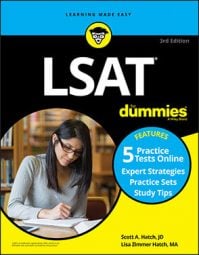When in doubt about the answer to a question, guess. Always guess. The LSAT test-makers don’t penalize you for wrong answers, so guessing doesn’t hurt, and you always have the chance that you may answer it right. What’s certain is that you won’t get it right if you don’t answer it at all.
The joy of statistics
How likely is it that you’ll get a question right by random guessing? Not very.
On questions where you have no idea of the correct answer, you have better luck if you pick a letter and stick to it for all your shots in the dark. Why? Each answer choice appears at more or less the same frequency. If you answer an entire test with one letter, you’ll probably get about 20 percent right.
You’d get the same results if the test were in a language you couldn’t read or if you didn’t bother to read the questions or answers. If you vary your answer choices from question to question, you just may miss everything.
Is Choice (B) really best?
Many people talk about which letter is statistically most likely to be the right answer. Many people recommend Choice (B) as the best choice. A little survey was conducted of some recent LSATs to see how many times each answer choice was correct.
In some sections, Choice (B) was more frequently correct; in others the winner was Choice (D). All in all, the percentage that each of the five answer choices was correct didn’t vary greatly. Based on this information, there isn’t any letter that would always be better than any other, though it would probably be a good idea to stick with Choice (B) or Choice (D).
Increase your odds: Eliminate the duds
A better strategy than random guessing from a pool of five choices is random guessing from a pool of two or three choices. Your odds of getting a right answer improve if you can eliminate a wrong answer or two.
To increase your odds, use a process of elimination to get rid of wrong answers on every question. Take this step first, unless you get one of those rare questions where the right answer jumps out at you. Crossing out the wrong answers — crossing them off in your test booklet so they don’t distract you — makes spotting the possible right answer easier.

